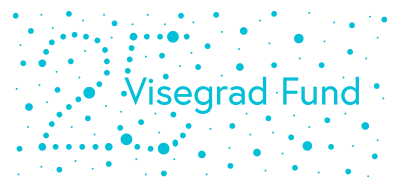The White Nights spent with Robert B. Lisek
We are happy to present artistic visual works of our former grantee Robert B. Lisek at The White Night – the festival of art.
During the last week of September, the windows of the Visegrad Fund premises are transformed into a living display case. And Hviezdoslavovo námestie in Bratislava is a bit more crowded these evenings. We hope you enjoyed the evenings and the festival with us!
Robert B. Lisek enthusiastically got involved in the festival days and spent several evenings not only preparing the artistic visual project Apeiron, but also presenting it during the festival. And because we had him personally at the Fund, we couldn’t resist asking:
- The Apeiron project was presented as part of the White Night Festival in Bratislava. What did you want to present to the audience?

The Aperion – Bratislava version – is prepared for the public space and addressed to a wide audience mainly using light and geometry to distort our understanding of time and space. I spend a lot of time destroying the codes that synthesize images and sounds. I am interested in the dynamics occurring in a man and his environment, the continuous process of diffusion, combining substances and ideas (transmutation), the emergence of structures from chaos and their re-dispersion. The project is based on ideas from physics and chemistry. It refers to the history of these sciences in the form of alchemy and its importance in culture. The Apeiron is an infinite, indefinite, ever-changing substance in which opposites exist in a certain unity.
- What do you think about the AI boom we are currently seeing? Is it possible to use AI to make art?
We produce huge amounts of data every day and we need methods to survive this flood. This process cannot be stopped. Machine learning and AI are natural tools. We are at the beginning of the journey. We use AI to make predictions and find/generate patterns. The current boom in Chat GPT and Large Langue Models shows that we can easily simulate natural languages. At the same time, it proves that our thinking is deeper than using natural language. These models are very poor at simulation rational thinking.
The dynamic development in this field creates challenges and threats to society. From a social perspective, the key question is: what is the process of loss of freedom in an AI-mediated world? My approach tests the concepts of privacy, agency and trust as they apply to artificial intelligence (AI). The power of data collected and analyzed goes far beyond monitoring and surveillance functions, enabling predictive control. Another problem is that the AI-mediated world is too homogeneous: currently both training data and mathematical models reflect narrow averages of mass experiences and interests that do not meet individual artistic needs. Moreover, artificial intelligence systems are now capable of generating large-scale disinformation that will create many false reflections of our culture.
- Visual arts are using colors, shapes, movements, moods and maybe much more… What message do you convey to the recipients?

Of course, visual and sound forms are very important because they have a very emotional and direct impact on the mind, introducing the mind to trance. I like working with large sound masses and noise, with very low and high frequencies, which have a very physical effect on the human body. At the same time, I like synthetic, sublime forms that work more abstractly and on a fundamental level.
The long-term goal of the APEIRON project is to create an independent and transparent application that analyzes the way we work with information. An application that allows you to take a comprehensive look at your online behavior and manage your own data to make informed decisions in the future. By creating an independent system that is transparent and self-regulating, individuals can regain control over their digital identity.
- You also have a background in mathematics. How can science go together with art?
Art is much more susceptible to ideological and political influence than science. Pure mathematics resembles pure art and gives a lot of freedom. At the same time, art is based on everyday practice, which is similar to natural sciences such as physics, chemistry and biology. Currently, I am interested in physics and concepts such as dark photon or antimatter. There are also many connections between mathematics and biology. There are so-called reaction-diffusion systems in which biological patterns may be the result of the reaction of molecules diffusing in space. I am interested in the evolutionary processes that take place on a microscale, how millions of versions of viruses are produced and how pathogens adapt to the environment. This case becomes especially fascinating when we consider the amazing connections of the worlds of mathematics, biology and other fields. This shows how unique life can be in the entire universe.
- You took part in several projects supported by the Visegrad Fund. What would you advice to young people who are interested in art?

Each of the projects had different goals and was based on cooperation with different environments. I also conducted many workshops and lectures between various cities in the Visegrad region. It is worth noting that it is programmers from our countries who are behind the current acceleration in AI (Large Language Models). We have extraordinary intellectual potential and talented people, but we are unable to use it economically. It is similar in the field of art, but we need to invest in these talents and build long-term programs. I don’t give advice to those who are entering art because artistic practice is a dark and destructive game, which, however, gives a great sense of freedom. I try to stay myself and develop my ideas.
